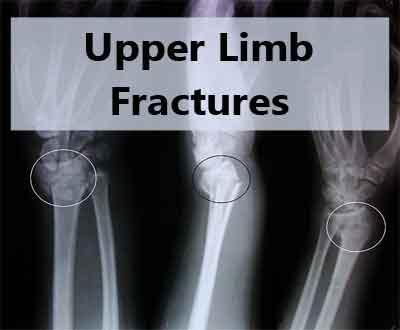- Home
- Editorial
- News
- Practice Guidelines
- Anesthesiology Guidelines
- Cancer Guidelines
- Cardiac Sciences Guidelines
- Critical Care Guidelines
- Dentistry Guidelines
- Dermatology Guidelines
- Diabetes and Endo Guidelines
- Diagnostics Guidelines
- ENT Guidelines
- Featured Practice Guidelines
- Gastroenterology Guidelines
- Geriatrics Guidelines
- Medicine Guidelines
- Nephrology Guidelines
- Neurosciences Guidelines
- Obs and Gynae Guidelines
- Ophthalmology Guidelines
- Orthopaedics Guidelines
- Paediatrics Guidelines
- Psychiatry Guidelines
- Pulmonology Guidelines
- Radiology Guidelines
- Surgery Guidelines
- Urology Guidelines
Upper Limb Fractures: Fracture of both bones forearm in adults - Standard Treatment Guidelines

The Ministry of Health and Family Welfare has issued the Standard Treatment Guidelines Critical Care for Upper Limb Fractures: Fracture of both bones forearm in adults. Following are the major recommendations:
Incidence :
1% of all fractures
Classification :
AO Classification :
Type A Fracture : simple fracture
- A1- simple fracture of ulna and radius is intact
- A2- simple fracture of radius and ulna is intact
- A3- simple fracture of both radius and ulna
Type B Fracture : wedge fracture
- B1- wedge fracture of ulna and radius intact
- B2-wedge fracture of radius and ulna intact
- B3-wedge fracture of both radius and ulna
Type C Fracture : complex fracture
- C1- ulna complex fracture and radius simple fracture
- C2- radius complex fracute and ulna simple fracture
- C3- complex fracture of both radius and ulna
History :
Fall on an outstretched hand or direct impact.
Diagnosis :
- Tenderness and swelling of the forearm
- Deformity
- Abnormal mobility and crepitus at fracture site.
Investigations :
- Routine radiographs of forearm with elbow and wrist in AP and LATERAL views are helpful in diagnosis and to rule out injuries of joint above and below.
- Other investigations such as BLOOD ROUTINE, CHEST RADIOGRAPHS, ECG and ECHOCARDIOGRAPHY performed for working up the patient for surgery.
- Doppler study done in case of suspected vascular injuries.
- Thorough neurological examination to rule out any injury to nerves.
Treatment : Mostly operative
Non Operative (in undisplaced fractures which are stable): If operative treatment is contraindicated because of the patient's poor general condition
1. Closed Reduction and Cast Immobilization
2. Functional Bracing for 6 weeks
Operative :
External Fixators- In case of open fractures with severe soft tissue damage and in maintaining length in fractures with severe bone loss. Later change into definitive fixation.
Intramedullary fractures- the anatomical reduction cannot be as accurate as can be achieved with plating. Plating of fractures of both bones is ideal either in LCDCP or LCP in osteoporotic fractures.
Plating- Most commonly used and permits accurate reduction of fracture.
Coplications :
- Compartment syndrome
- Malunion
- Non union
- Infection
- Radio-ulnar synostosis
- Plate removal and refracture
- Neurovascular complications
Fractures That Need To Be Referred To Higher Centres :
- Open fractures with severe soft tissue loss
- Fractures associated with bone loss and vascular injuries
- Polytrauma patients after initial stabilization
- Complex fractures
Comments:
The common deficiency
(e) The writing style is not consistent. Radial head fracture is given as 33% of elbow region while distal radius as 1/6 of fracture (not known) of what?
(f) Imaging – just mentioned AP, Lateral and sometime oblique. Why and for what a particular special x-ray is needed?
(g) Complication has been clubbed as most common to least common, early or late in one list. This will not help.
(h) When to refer – Generally written type B & C to higher center. Can we make such guidelines in the issue.
The outcome of treatment depends on –
c) Training of the surgeon.
d) Infrastructure – operating theatre & available instrumentation
We need to define what all we should have in primary health center, secondary and tertiary care centre. If we refer all type B & C fracture for all fractures than how the patients in Village, Tehsil, District will be treated as we do not have any networking of referral centers (they are all concentrated in the cities.
Summarily the objective of the guidelines should be well stated. Is it to stop small centers in cities to stop operating the particular type of fractures and force them to refer or to make a national policy for the overall effective management of the orthopaedic patients?
Guidelines by The Ministry of Health and Family Welfare :
Group Head Coordinates of Development Team Dr. P.K. DAVE, Rockland Hospital, New Delhi Dr. P.S. Maini, Fortis Jessa Ram Hospital, New Delhi
Reviewed By
Dr. V.K. Sharma, Professor Central Instiute of Orthopaedics, Safdarjung Hospital, New Delhi

Disclaimer: This site is primarily intended for healthcare professionals. Any content/information on this website does not replace the advice of medical and/or health professionals and should not be construed as medical/diagnostic advice/endorsement or prescription. Use of this site is subject to our terms of use, privacy policy, advertisement policy. © 2020 Minerva Medical Treatment Pvt Ltd